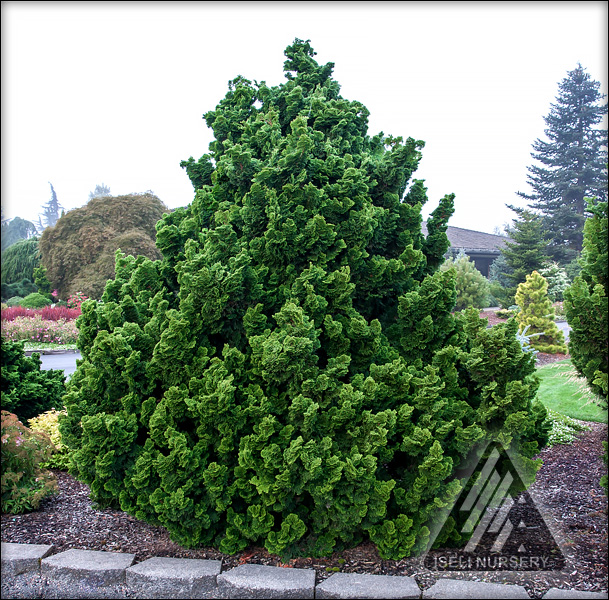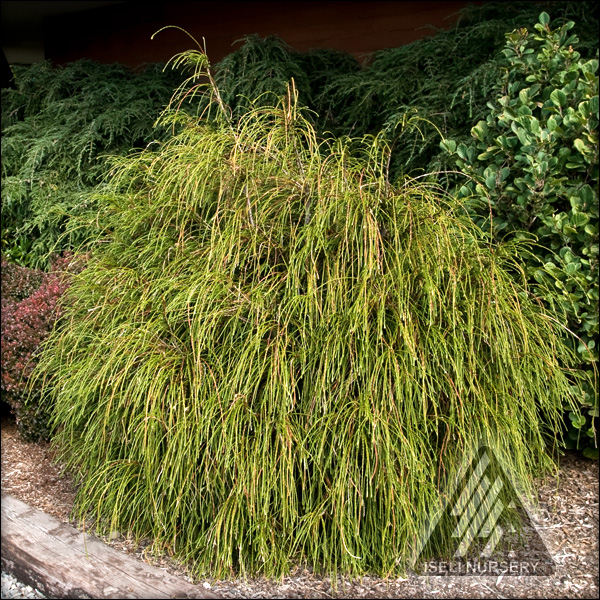In the ornamental conifer world few plants are “invented” or created. While there is some hybridization, there is nothing in ornamental conifers that begins to approach the spectacular work done in the flower world of Iris, Rose, Lily, Azalea and countless other beauties. Most new ornamental dwarf conifer plants are accidents of nature that have been discovered. Nearly all are the spontaneous mutation of an existing plant, or a seedling whose genetic combination came up significantly different than its parent.
In the conifer world there are significant hybridization programs, however they are largely in the industrial forestry areas attempting to find bigger and faster growing trees-not exactly what we’re looking for. Here at Iseli Nursery we have collected open pollination seed from dwarf conifers during the infrequent heavy cone setting years and planted them out for evaluation. The results are varied and some new varieties have resulted from the efforts.

Nineteen years ago a large crop of seed was collected from Chamaecyparis obtusa ‘Nana Gracilis’ at Iseli Nursery. Jean Iseli had a goal of finding a dwarf blue seedling of this species. Of the more than 50,000 seedlings that were grown from this crop, the majority were compact and green similar to the parent ‘Nana
Gracilis.’ This crop also produced the entire range of sizes, in both green and yellow, from micro-miniature to large trees. A blue selection was not found. Many beautiful plants could have been named and propagated but the goal of Iseli Nursery is to introduce plants that are significantly different than currently available selections. Today we are continuing to evaluate nine selections from the crop of 50,000 seedlings started 19 years ago and of these, we may name and introduce only one or two.
Some conifer species, like Picea abies, mutate prolifically. There seem to be endless variations of this genus/specie which challenge the horticulturist to introduce plants that are not just different, but actually better, more durable, and specific for the landscape. Others species rarely mutate, but offer an exciting opportunity for the plant world when they do. Most of these mutations are discovered in the wild by enthusiasts who spend countless hours appreciating the beauty of nature as they spy towards the heavens looking for witches brooms or congested areas of trees that may yield the next diminutive beauty. After locating the tree with a sport, which seldom is within reach from the ground, they get out their field glasses to inspect their find if one of them is not catlike enough to climb up for a closer view. The dangers and personal risk taken to find these pearls of nature are often under appreciated. If the collector believes the sport merits attention, they will record the spot to return during the winter dormant season to collect a sample.

Cuttings from the sport are brought home to attempt rooting. Unfortunately, only a minority of these sports will root, and even fewer will grow to be a replica of the sport or mutation. The technique of grafting is used when collected cuttings are presumed un-rootable (based on experience with like species). Unfortunately, while cuttings have a high likelihood of being a perfect replica of the stock they were taken from, some grafts do not perform the same replication. Due to the vigor of the understock, or some other reason, the graft may look significantly different than the same plant replicated by rooting. Picea mariana ‘Ericoides’ is a gorgeous cultivar grown from cuttings. As a cutting this plant is reproduced perfectly. Grafted on Picea abies, the result looks like the spike haired, body pierced, metal dangling teenager you didn’t intend to get when you raised your child! We’ll stay with cuttings.
The discovery of a new seedling is a special event. They are nearly always genetically stable, being the result of a natural hybridization. Many new dwarf conifers were discovered before being thrown away as culls in forestry seedling nurseries. With millions of seedlings produced at the grower’s feet, the evaluation of the odd plant in a seedling bed is much easier than the mountain trek among thousands of trees in the forest. Hopefully these discoveries can be rooted so we can propagate them quickly and successfully. At Iseli nursery we have received some of these selected seedlings from our understock supplier Drakes Crossing Nursery. Thuja plicata ‘Whipcord’ is a great example. This dwarf, with its’ rope like foliage, grows to a broad pyramidal mound in contrast to its parent, the tall and stately Thuja plicata (western red cedar).
It is our responsibility as nurserymen to critically evaluate potential new cultivars. They must be durable plants with a clear difference or improvement for the gardening consumer, and not just a minute difference in needle length. We must test for hardiness both from heat and cold and their tolerance to excessive moisture, drought and direct sunlight. The new plant may be one that fulfills a need in a geographic area that no earlier plant has in that hardiness zone. Brilliant yellow foliage, that doesn’t burn, would be an improvement over a yellow that burned. A predictably blue version of Picea glauca ‘Conica’ (dwarf Alberta spruce) would be a natural companion to the ever-popular green form. The most important point is that plant variations, including conifers, are infinite. Iseli Nursery is dedicated to introduce plants that fit useful landscape situations and that have unique desirable characteristics.
The collectors’ reward is seeing their new discovery accepted in a variety of new planting environments throughout the nation and world. We trade plants with these “eagle eyes” and provide them with many of our first successes at replication. For the garden center or commercial nurseryman who shares with us, we provide them the first call on our production so they may be the first to introduce their discovery.
Eventually, when our production is sufficient, we will have the opportunity of sharing the plant with the balance of the horticultural world. Iseli nursery was built with the vision and perseverance of those “plant detectives” who entrusted us to evaluate and eventually bring to market their discoveries. Jean Iseli had so many collector friends; we are forever indebted to them and have rededicated ourselves to those individuals and their endeavors.

You must be logged in to post a comment.